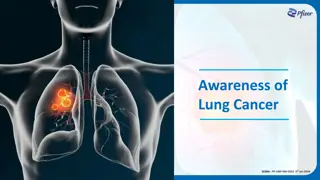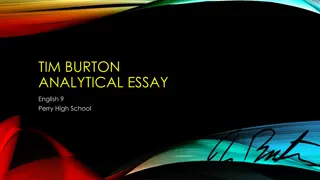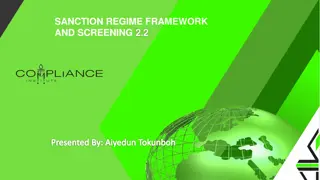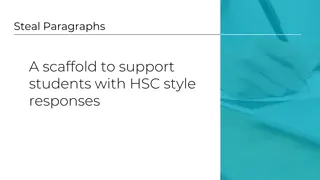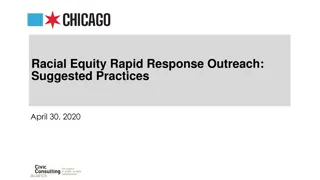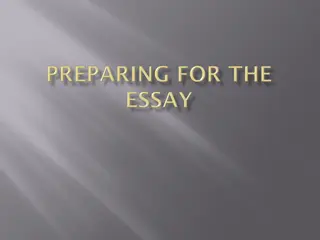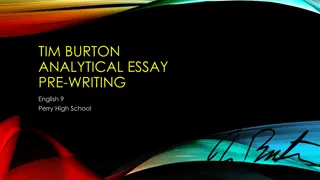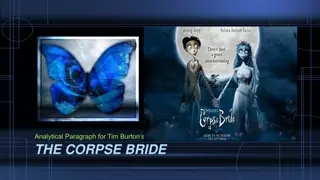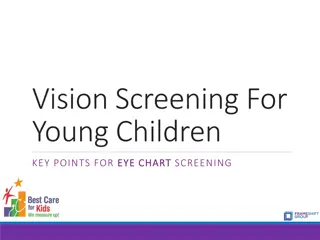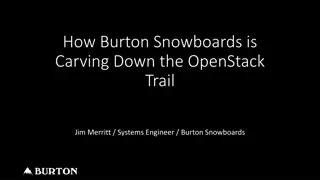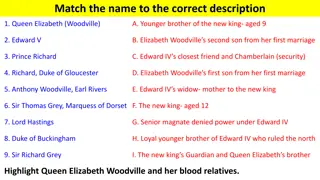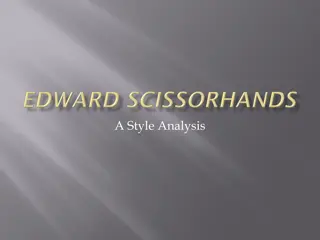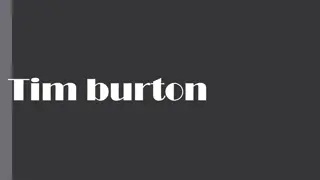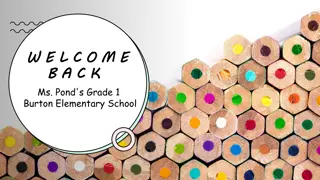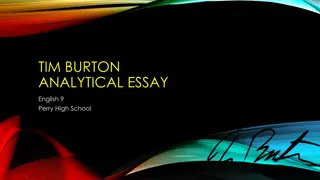Exploring Tim Burton's Style Through "Edward Scissorhands" Screening Activities
Delve into the world of Tim Burton's film "Edward Scissorhands" through a series of screening activities focusing on analyzing the style of the movie. From examining the opening credits to discussing scene details and character connections, these activities provide a comprehensive look at the creative elements employed by the director. Explore themes, cinematography, and music choices to gain a deeper understanding of this iconic film.
Download Presentation

Please find below an Image/Link to download the presentation.
The content on the website is provided AS IS for your information and personal use only. It may not be sold, licensed, or shared on other websites without obtaining consent from the author.If you encounter any issues during the download, it is possible that the publisher has removed the file from their server.
You are allowed to download the files provided on this website for personal or commercial use, subject to the condition that they are used lawfully. All files are the property of their respective owners.
The content on the website is provided AS IS for your information and personal use only. It may not be sold, licensed, or shared on other websites without obtaining consent from the author.
E N D
Presentation Transcript
Edward Scissorhands Screening Activities for a Style Analysis Link to all clips: https://sites.google.com/site/mrstestajfk/classroom- news/untitledpost
Opening Credits As we view the opening credits to Tim Burton s film Edward Scissorhands, record your observations in the chart on the page Reading Film: Edward Scissorhands What is happening in the scene? What are the images? What shapes do you see? What type of music is played?
Group Discussion What can you infer or predict based on your observations?
Partner Discussion Discuss the following questions with your partner and record your findings at the bottom of your handout. 1. Describe the TONE in this scene. What type of movie does it remind you of? 2. How does the lighting help create the MOOD of this opening?
Opening Scene As we view the opening scene continue to record your observations on your chart. What is happening in this scene? How is the camera moving to highlight specific details in the scene?
Group Discussion What can you infer or predict based on your observations?
Partner Discussion Discuss the following questions with your partner and record your findings on your handout. 1. How has the music changed between the opening credits and this scene? Why? 2. What does the camera do when it leaves the room where the story is being told? Why do you think Tim Burton does this? 3. What do you think this film will be about? On what do you base your prediction?
Screening Day A As we watch this scene pay careful attention to any cinematic techniques that are used to emphasize the setting and the characters. **Remember we are viewing for analysis, so be careful to mentally note your findings.
Group Discussion In your groups, discuss and answer the questions on the handout, Reading Film: Screening Day A 1. What do you know about Peg from this segment? 2. How has the director already established a connection between Edward and Kim? 3. How do you feel about Edward? What do you think will happen to him? 4. How do you feel about the town? Why do you feel this way?
Splitting and Sharing Choose a cinematic technique to take notes on while watching the film and record them in the column you are observing. Be sure that each cinematic technique is covered in your group you may be responsible for more than one. Once we have viewed the scene and you have recorded notes for your cinematic technique(s), find one person in the room who also watched for the same technique and compare your findings. Now, go back to your seat and share your notes with your group filling in the rest of the columns.
Understanding the Analytic Triangle Purpose of the cinematic technique WHAT/WHY? Example(s) of this cinematic element WHERE? Effect(s) of this cinematic choice HOW?
Writing an Analytical Statement Tim Burton, in Edward Scissorhands, uses a long shot in order to show the vulnerability of characters. For example, when Peg is upstairs in the castle, the long shot makes her look small so that the viewer worries about her safety.
Homework Using the formula we just discussed and following the notes on your handout, write an analytical statement for one of your selected cinematic elements that you observed and took notes on. You may write your analytical statement at the bottom of your handout. Be ready to share this tomorrow with your group.
Screening Day B As we watch this scene pay careful attention to any cinematic techniques that are used to emphasize the setting and the characters. **Remember we are viewing for analysis, so be careful to mentally note your findings.
Group Discussion In your groups, discuss and answer the questions on the handout, Reading Film: Screening Day B 1. Why do the townspeople welcome Edward so quickly into their lives? 2. How does the town seem to change after Edward s arrival? 3. Kim s reaction to Edward is played for humor, but in what way is hers the most natural or realistic response? 4. What hints in this segment indicate that all will not work out well?
Splitting and Sharing Choose a cinematic technique to take notes on while watching the film and record them in the column you are observing. Be sure that each cinematic technique is covered in your group you may be responsible for more than one. Once we have viewed the scene and you have recorded notes for your cinematic technique(s), find one person in the room who also watched for the same technique and compare your findings. Now, go back to your seat and share your notes with your group filling in the rest of the columns.
Writing an Analytical Statement with Reflective Commentary *The Reflective Commentary is the elaboration/explanation element of your analytic statement. Tim Burton, in Edward Scissorhands, uses a long shot in order to show the vulnerability of characters. For example, when Peg is upstairs in the castle, the long shot makes her look small so that the viewer worries about her safety. By making viewers worry about Peg s safety, Burton is setting up Edward as a potential villan, even though it quickly shifts to showing him as an awkward loner.
Teamwork Using the analytical statement formula with the reflective commentary and the notes on your handout, write an analytical statement for one of your selected cinematic elements that you observed and took notes on. Share your statement and commentary with your group. Choose a cinematic technique and the best parts of each person s statements, and as a group write a new analytical statement with reflective commentary. Be ready to share with the class in a few minutes.
Screening Day C Today, we will continue to watch scenes from Edward Scissorhands. Like the previous lessons, you will make note of the cinematic techniques used in the film. Use your handout, Reading Film: Screening Day C to record all of your notes. Pay careful attention to these factors in the scenes. 1. Is Edward behaving differently than before? 2. What is the effect of the scene with Kim dancing in the crystals? How have her feelings about Edward changed? Why? 3. How has Edward tried to fit in? Why has he failed? What does the ethics lesson reveal about Edward?
Notes and Group Discussion Share your notes with your group on the cinematic techniques you observed in this clip and answer the questions as a group.
Writing an Analytical Statement with Reflective Commentary and a Statement of Closure Your Analytical Statement with Reflective Commentary is not complete without closure. Now, you will add on a Statement of Closure to finalize your analysis. Tim Burton, in Edward Scissorhands, uses a long shot in order to show the vulnerability of characters. For example, when Peg is upstairs in the castle, the long shot makes her look small so that the viewer worries about her safety. By making viewers worry about Peg s safety, Burton is setting up Edward as a potential villain, even though it quickly shifts to showing him as an awkward loner. Therefore, Burton is able to portray Edward as the anti-hero through the use of long shot which makes him seem lonely and non-threatening.
Homework Look over all of your notes you have taken on Cinematic Techniques. Choose one technique to analyze in a well-developed paragraph. Remember to use each step we have practiced in the last few days Analytical Statement Reflective Commentary Statement of Closure



